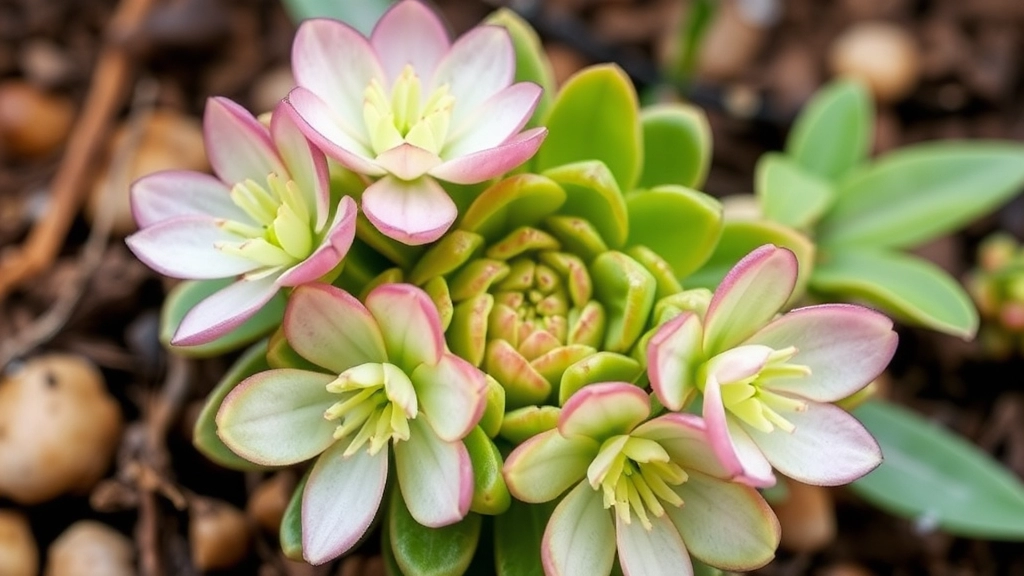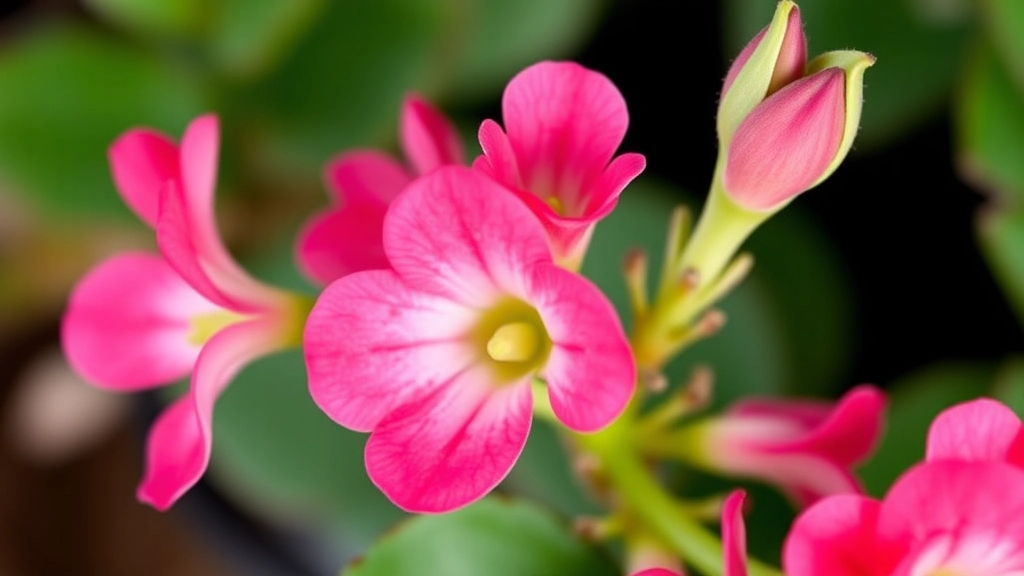Kalanchoe Mother of Thousands Flower Care
When it comes to the Kalanchoe Mother of Thousands Flower, understanding its care and growth is crucial for any plant enthusiast. This unique succulent, known for its striking foliage and rare blooms, requires specific conditions to thrive. Let’s delve into the ideal growing conditions, how to encourage flowering, and effective propagation methods to help you get the best out of this fascinating plant.
Ideal Growing Conditions
To start with, the Kalanchoe Mother of Thousands needs plenty of sunlight and well-draining soil to flourish. While it rarely flowers indoors, providing the right environment can sometimes lead to its beautiful pinkish-grey tubular blooms.
Propagation Methods
Propagation is straightforward, thanks to its plantlets that easily take root. However, be mindful of its invasive nature and take steps to contain its spread. By following these tips, you can enjoy a healthy and vibrant Kalanchoe Mother of Thousands in your home or garden.
To ensure your Kalanchoe Mother of Thousands thrives, consider the following ideal growing conditions:
**Light Requirements**
– **Bright, Indirect Light**: Kalanchoe Mother of Thousands thrives in bright, indirect sunlight. Direct sunlight can scorch its leaves.
– **Artificial Lighting**: If natural light is limited, consider using grow lights to mimic its native environment.
**Temperature and Humidity**
– **Optimal Temperature**: This plant prefers temperatures between 18°C to 24°C. Avoid exposing it to frost.
– **Humidity Levels**: Kalanchoe Mother of Thousands enjoys low to moderate humidity. Too much moisture can lead to rot.
**Soil Composition**
– **Well-Draining Soil**: Use a cactus or succulent potting mix. You can also create your own by mixing regular potting soil with sand or perlite for better drainage.
– **pH Level**: Aim for a slightly acidic to neutral pH (around 6.0 to 7.0) for optimal growth.
**Watering Practices**
– **Drench and Dry**: Allow the soil to dry out completely between waterings. Overwatering is a common mistake that can lead to root rot.
– **Seasonal Adjustments**: During the growing season (spring and summer), water more frequently. In autumn and winter, reduce watering.
**Fertilisation**
– **Balanced Fertiliser**: Feed your Mother of Thousands with a balanced, diluted fertiliser during the growing season to encourage healthy growth.
– **Frequency**: Fertilise every 4-6 weeks for best results.
For more detailed information, you can check out the [Kalanchoe Mother of Thousands Care Guide](https://planthq.org/kalanchoe-mother-of-thousands-care-guide-tips-techniques/) and the [Health Benefits of Kalanchoe Mother of Thousands](https://planthq.org/kalanchoe-mother-of-thousands-top-health-benefits/).
How to Encourage Flowering in Mother of Thousands

So, you’ve got your Kalanchoe Mother of Thousands, and you’re eager to see those stunning flowers bloom.
But why isn’t it flowering?
Don’t worry; you’re not alone in this. Many plant lovers face the same dilemma.
Here’s how to encourage your plant to show off its beautiful blooms!
1. Light, Light, Light!
Your Mother of Thousands craves bright, indirect sunlight.
- Location: Place it near a south or west-facing window.
- Duration: Aim for at least 6 hours of light daily.
Too little light? You might end up with a lush green plant but no flowers.
2. Temperature Matters
These plants thrive in warm conditions.
- Ideal Range: Keep the temperature between 18°C to 24°C (65°F to 75°F).
- Avoid Cold: Protect it from drafts and cold spots, especially in winter.
A cozy environment can work wonders for flower production!
3. Watering Wisely
Overwatering is a common mistake that can stifle flowering.
- Frequency: Water when the top inch of soil feels dry.
- Drainage: Ensure your pot has good drainage to prevent soggy roots.
Keeping your plant hydrated but not drowning is key to encouraging blooms.
4. Fertilising for Flowers
A little boost can go a long way!
- Type: Use a balanced, water-soluble fertiliser.
- Frequency: Feed every 4-6 weeks during the growing season (spring and summer).
Just like us, plants need their nutrients to thrive!
5. Stress for Success
Sounds odd, right? But a bit of stress can trigger flowering.
- Reduce Watering: Slightly cut back on water before the blooming season.
- Temperature Drop: A brief cooler period can also encourage flowering.
This method mimics natural conditions and can lead to a rewarding bloom.
6. Patience is Key
Sometimes, you just need to give it time.
Each plant has its own rhythm and may take a while to flower.
Keep nurturing it, and you might just be rewarded with a stunning display!
Propagation Through Plantlets: A Step-by-Step Guide
Are you looking to expand your Kalanchoe Mother of Thousands collection?
This plant is renowned for its ability to produce numerous plantlets, making propagation a straightforward and rewarding process.
Step 1: Identify Healthy Plantlets
- Look for plantlets that are at least a few inches long.
- Ensure they are healthy, vibrant, and free from pests.
Step 2: Gather Your Tools
- Prepare a clean, sharp knife or scissors for cutting.
- Have a small pot filled with well-draining soil ready.
- Keep a spray bottle filled with water handy.
Step 3: Remove the Plantlets
- Gently twist or cut the plantlets from the mother plant.
- Be careful not to damage the mother plant or the roots of the plantlets.
Step 4: Allow to Callous
- Place the cut plantlets in a dry, shaded spot for a few hours.
- This allows the cut ends to callous over, reducing the risk of rot when planted.
Step 5: Plant the Plantlets
- Once calloused, gently press the plantlets into the soil.
- Ensure the cut end is buried, while the leaves remain above soil level.
- Lightly mist the soil to keep it slightly moist.
Step 6: Provide Optimal Conditions
- Place the pots in a warm, bright location, but avoid direct sunlight initially.
- Keep the soil moist but not soggy, using the spray bottle as needed.
Step 7: Monitor Growth
- After a few weeks, roots should develop.
- You’ll notice new growth as the plantlets establish themselves.
For more detailed information on this plant, check out our guide on propagating Kalanchoe Mother of Thousands. Additionally, you might find our care guide for Kalanchoe Mother of Millions helpful for further tips on nurturing your plant collection.
Common Care Mistakes and How to Avoid Them

As we delve deeper into the care of Kalanchoe Mother of Thousands, it’s essential to address common pitfalls that can hinder its growth and vitality. Many enthusiasts, including myself, have faced challenges that could have been easily avoided with a little knowledge.
Overwatering
One of the most frequent mistakes is overwatering.
- Signs: Yellowing leaves, mushy stems, or a foul odour from the soil.
- Solution: Allow the top inch of soil to dry out before watering again. A well-draining potting mix is crucial.
Insufficient Light
Kalanchoe thrives in bright, indirect light.
- Signs: Leggy growth or a lack of flowering.
- Solution: Position your plant near a window with filtered sunlight. If indoors, consider using grow lights during darker months.
Neglecting Fertilisation
Many forget to fertilise their Kalanchoe, leading to poor growth.
- Solution: Use a balanced, water-soluble fertiliser every four to six weeks during the growing season.
Ignoring Pest Issues
Pests like mealybugs and aphids can be a nuisance.
- Signs: Sticky residue on leaves or visible bugs.
- Solution: Regularly inspect your plant and treat any infestations promptly with insecticidal soap or neem oil.
Poor Container Choice
Using the wrong pot can impede growth.
- Solution: Choose pots with drainage holes to prevent waterlogging, which can lead to root rot.
Best Practices for Repotting and Containing Spread
Repotting your Kalanchoe Mother of Thousands can feel daunting, especially if you’re worried about its tendency to spread. However, with the right approach, you can manage its growth effectively while ensuring a healthy plant.
When to Repot
- Timing: The best time to repot is during the growing season, typically in spring or early summer.
- Signs: Look for roots emerging from the drainage holes or soil that dries out too quickly.
How to Repot
- Choose the Right Pot:
- Select a pot that is one size larger than the current one.
- Ensure it has drainage holes to prevent waterlogging.
- Prepare the Soil:
- Use a well-draining soil mix, ideally a cactus or succulent blend.
- You can add perlite or sand for extra drainage.
- Remove the Plant:
- Gently loosen the soil around the edges.
- Carefully lift the plant, taking care not to damage the roots.
- Trim Excess Roots:
- If roots are overcrowded, trim them back slightly.
- Remove any dead or rotting roots.
- Replant:
- Place the plant in the new pot and fill with soil, ensuring the base of the plant is level with the soil surface.
- Water lightly to settle the soil.
Controlling Spread
Kalanchoe Mother of Thousands is known for its prolific growth through plantlets. Here’s how to manage that:
Seasonal Changes and Overwintering Tips for Indoor and Outdoor Growth
So, you’ve got your Kalanchoe Mother of Thousands thriving, but what happens when the seasons change?
Understanding Seasonal Changes
As the seasons shift, your plant’s needs will change too.
- Spring and Summer: This is the prime growing season. Your Kalanchoe will soak up the sun and flourish.
- Autumn: As temperatures drop, it’s time to reduce watering. The plant will enter a resting phase.
- Winter: If you’re in a cooler climate, your Mother of Thousands needs special care to survive the cold.
Overwintering Tips for Indoor Growth
If you’re keeping your plant indoors, here’s how to help it thrive through winter:
- Light: Ensure it gets plenty of bright, indirect light. A south-facing window is ideal.
- Temperature: Keep it in a warm spot, ideally between 15°C to 21°C. Avoid drafts!
- Watering: Cut back on watering. Only water when the soil is completely dry. Overwatering is a common killer during winter.
- Humidity: Kalanchoe prefers dry air, so don’t worry about humidity. Just ensure good airflow.
Overwintering Tips for Outdoor Growth
If your plant is outside, here’s what to do:
- Bring it Inside: If temperatures drop below 10°C, it’s time to bring your plant indoors.
- Mulching: If you can’t bring it inside, add a layer of mulch to protect the roots from frost.
- Watering: Just like indoors, reduce watering. The plant needs less moisture in cooler weather.
By keeping these tips in mind, you can help your Kalanchoe Mother of Thousands survive the chilly months. For more detailed information on care, check out our complete care and propagation guide for Mother of Thousands. Additionally, if you’re interested in the unique characteristics of this plant, our Mother of Millions care guide can provide further insights.
FAQs on Kalanchoe Mother Of Thousands Flower
How much light does the Mother of Thousands need to flower?
The Mother of Thousands craves bright, indirect sunlight. Aim for at least 6 hours of light daily. Position it near a south or west-facing window for optimal results.
What temperature range is ideal for the Mother of Thousands?
These plants thrive in warm conditions, ideally between 18°C to 24°C (65°F to 75°F). Protect it from drafts and cold spots, especially in winter.
How often should I water my Mother of Thousands?
Water the plant when the top inch of soil feels dry. Overwatering can stifle flowering, so ensure your pot has good drainage to prevent soggy roots.
What type of fertiliser should I use, and how often?
Use a balanced, water-soluble fertiliser. Feed your plant every 4-6 weeks during the growing season (spring and summer) to encourage blooming.
Can stressing the plant help it flower?
Yes, a bit of stress can trigger flowering. Slightly reduce watering before the blooming season and consider a brief cooler period to mimic natural conditions.
Why is my Mother of Thousands not flowering?
There could be several reasons, including insufficient light, improper temperature, overwatering, or lack of nutrients. Patience is also key, as each plant has its own rhythm and may take a while to flower.
What are common care mistakes to avoid?
Common mistakes include overwatering, insufficient light, neglecting fertilisation, ignoring pest issues, and using poor container choices. Addressing these can significantly improve your plant’s health and flowering potential.
How can I identify and solve overwatering issues?
Signs of overwatering include yellowing leaves, mushy stems, or a foul odour from the soil. Allow the top inch of soil to dry out before watering again and use a well-draining potting mix.
What should I do if my plant has insufficient light?
If your plant shows leggy growth or a lack of flowering, it might need more light. Position it near a window with filtered sunlight or use grow lights during darker months.
How can I deal with pest issues on my Mother of Thousands?
Common pests include mealybugs and aphids. Look for sticky residue on leaves or visible bugs. Treat infestations promptly with insecticidal soap or neem oil and regularly inspect your plant.
What type of container is best for my Mother of Thousands?
Choose pots with drainage holes to prevent waterlogging, which can lead to root rot. A well-draining container will support healthy growth and flowering.
References
-
Mother Of Thousands Plant: Tips For Growing Kalanchoe Daigremontiana
-
How to Grow and Care for Mother of Thousands
-
Kalanchoe: How to Grow and Care for Kalanchoe Plants
